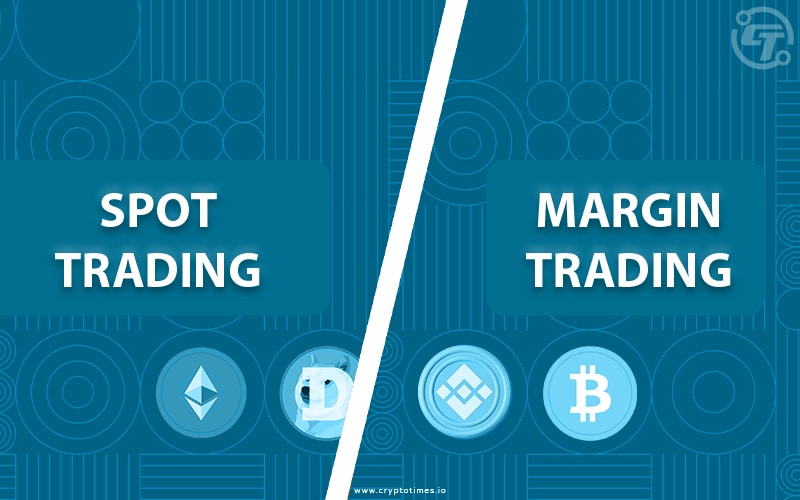Cryptocurrency has emerged as a new asset class in recent years, and its popularity among traders and investors has been growing rapidly. With the rise of digital currencies, traders around the world are increasingly turning to cryptocurrency trading as a way to diversify their investment portfolios and take advantage of the volatile market movements.
When it comes to cryptocurrency trading, two popular approaches are spot trading and margin trading. Spot trading involves buying and selling digital assets at the current market price, while margin trading allows traders to leverage their trades by borrowing funds from a broker or exchange to trade cryptocurrencies.
In this article, you will find a brief discussion about spot and margin trading in crypto space and key differences between them. So, let’s begin.
Spot Trading
Spot trading in cryptocurrency refers to the buying and selling of digital assets at the current price for immediate delivery. This means that the trade is settled on the spot or immediately once the transaction is executed. However, spot trading is also used in the regular stock market.
In spot trading, buyers and sellers agree on the price of the cryptocurrency, and the buyer pays the seller in exchange for the agreed-upon amount of the cryptocurrency. The cryptocurrency is then transferred to the buyer’s digital wallet.
Before jumping into spot trading, one needs to have an understanding of these three terms related to it.
1. Spot Price
The spot price is the current market price at which a particular cryptocurrency can be bought or sold for immediate delivery. Simply put, it is the price of the cryptocurrency at the current moment in time, and it is the price at which traders buy and sell the cryptocurrency in the spot market. The spot price is determined by supply and demand and can fluctuate rapidly, in a fraction of the time.
2. Trade Date
The trade date is the date on which a trader buys or sells a cryptocurrency in the spot market. It is the date on which the transaction takes place and the trade is executed.
3. Settlement Date
The settlement date is the date on which the buyer and seller of a cryptocurrency trade must exchange payment and transfer ownership of the cryptocurrency. Settlement typically occurs a few days after the trade date, and it allows time for the parties to transfer funds and cryptocurrency securely. The settlement date is also sometimes referred to as the delivery date.
Spot trading is the most common form of crypto trading and is popular among traders who want to take advantage of short-term price signals in the cryptocurrency market.
Some popular cryptocurrency exchanges that support spot trading include Bisq, Coinbase, Kraken, and Bitfinex.
Pros of Spot Trading
- Simpler to use compared to perpetual swaps contracts
- Traders can buy assets and hold them for prices to raise and earn profits
- The process is easier to grasp and understand for future trading crypto
Cons of Spot Trading
- Missed earning opportunities linked with potential gains through futures and perpetual swaps
- Complex terms such as leverage, margin trading, and liquidation can be intimidating for new traders
- Future contracts are often purchased by expert traders.
Margin Trading
Margin trading in crypto refers to the practice of borrowing funds from a broker or exchange to trade cryptocurrencies. With margin trading, traders can leverage their trades, which means they can control more cryptocurrency than they would be able to with their own funds.
Before going forward, let’s understand two common terms related to margin trading.
1. Leverage
Leverage is a tool used in margin trading that allows traders to borrow funds from a platform to increase their buying power.
2. Liquidation
Collateral liquidation refers to the process by which a platform forcibly sells a trader’s assets to repay their debt when the value of their collateral falls below a certain threshold.
In margin trading, traders can use their existing funds and borrow additional funds from the broker or exchange to increase their buying power. This borrowed amount is known as “margin,” and the trader must pay interest on the borrowed amount.
Margin trading can amplify both profits and losses. If a trader makes a successful trade, the profit will be magnified by the amount of leverage used. However, if a trade goes against the trader, losses will also be amplified.
For example, some exchanges provide 2x leverage on their trade, which means if the trader has a $500 balance, he/she can bet for a $1000 trade, allowing him to cover 2x profits. Conversely, it also poses a higher risk as traders can lose all their money if it slips below liquidation value.
To perform margin trading, one needs high experience in crypto trading and a better understanding of the crypto market’s dynamics. As crypto’s a highly volatile asset class, it would be better for traders to rethink their risk management strategies. Popular cryptocurrency exchanges that offer margin trading include BitMEX, Binance, KuCoin, and Kraken.
Pros of Margin Trading
- Enables traders to increase potential profits through leverage
- Traders can enter larger positions than their available capital allows
- Can be used to hedge positions and manage risk
- Margin trading platforms often offer advanced tools and features for technical analysis and risk management
Cons of Margin Trading
- Increased potential for losses due to higher leverage
- Requires a solid understanding of trading and risk management principles
- Margin calls and liquidations can occur if trades move against the trader
- Margin trading can lead to overtrading and emotional decision-making if not managed properly
Spot Trading vs Margin Trading
| Spot Trading | Margin Trading | |
| Definition | Buying and selling assets for cash | Borrowing funds to buy/sell assets |
| Leverage | No leverage | Leverage can be used to increase trade purchase |
| Funding | Through existing crypto assets | Trader can leverage borrowed funds from broker and exchange |
| Risk | Less Risk in comparison to margin trading | Trader could lose all funds if the trade value slips below to liquidation value |
| Interest | No interest taken on spot trading | Interest applied due to borrowed fund |
| Time Horizon | Short to medium-term trading | Short-term to long-term trading |
| Volatility | Lower volatility due to no leverage | Higher volatility due to leverage |
Also Read: The Best Crypto Tools for Growing Your Portfolio in 2023
Conclusion:
Spot trading and margin trading are two distinct and powerful approaches to trading in the cryptocurrency markets. Spot trading involves buying and selling assets for cash, while margin trading involves borrowing funds to buy or sell assets, with the use of leverage. Each approach comes with its different advantages and risks, and it’s important for traders to understand these differences before deciding which approach to take.
Trading experts suggest that spot trading is a safer and more reliable approach, especially for beginners. On the flip side, margin trading can be a powerful tool for experienced traders who know how to use leverage to their favour. However, it also comes with higher risks and potential losses.
Ultimately, the choice between spot trading and margin trading in cryptocurrency will depend on the trader’s individual goals, risk appetite, and level of experience.







